In a world where the visual is becoming an integral part of knowledge, visuals can also express scholarly knowledge.
As such, for the 2019 conference, the Central Eurasian Studies Society (CESS) organized its first-ever photo contest under the title: “The Researcher and His/Her Fieldwork in Central Eurasia“. In the gallery below, scholars and journalists present photos that reflect on the relationship between the researcher and the object of research and illuminate the different faces of fieldwork.
Photos by:
Abel Polese, Aksana Ismailbekova, Alexandru Badarau, Assel Choibekova, Cara Kerven, Kasia Ploskonka, Christian Kelly Scott, Everett Price, Jennifer Murtazashvili, Katerina Zach-Kozlova, Liliya Karimova, Matthew Brown, Moira O’Shea, Rashid Gabdulhakov, Farit Gabdulhakov, Snejana Atanova, Verena La Mela, Nyani Quarmyne, Laura Salm-Reifferscheidt and Talant Sultanov.
Abel Polese




Aksana Ismailbekova

Alexandru Badarau

Assel Choibekova



Cara Kerven





Christian Kelly Scott

Everett Price

Farit Gabdulhakov

Jennifer Murtazashvili

Kasia Ploskonka

Kateřina Zäch-Kozlová



Liliya Karimova

Matthew Brown

Moira O’Shea



Rashid Gabdulhakov

Snejana Atanova

Nyani Quarmyne
text by Laura Salm-Reifferscheidt, submitted by Talant Sultanov




Verena La Mela















